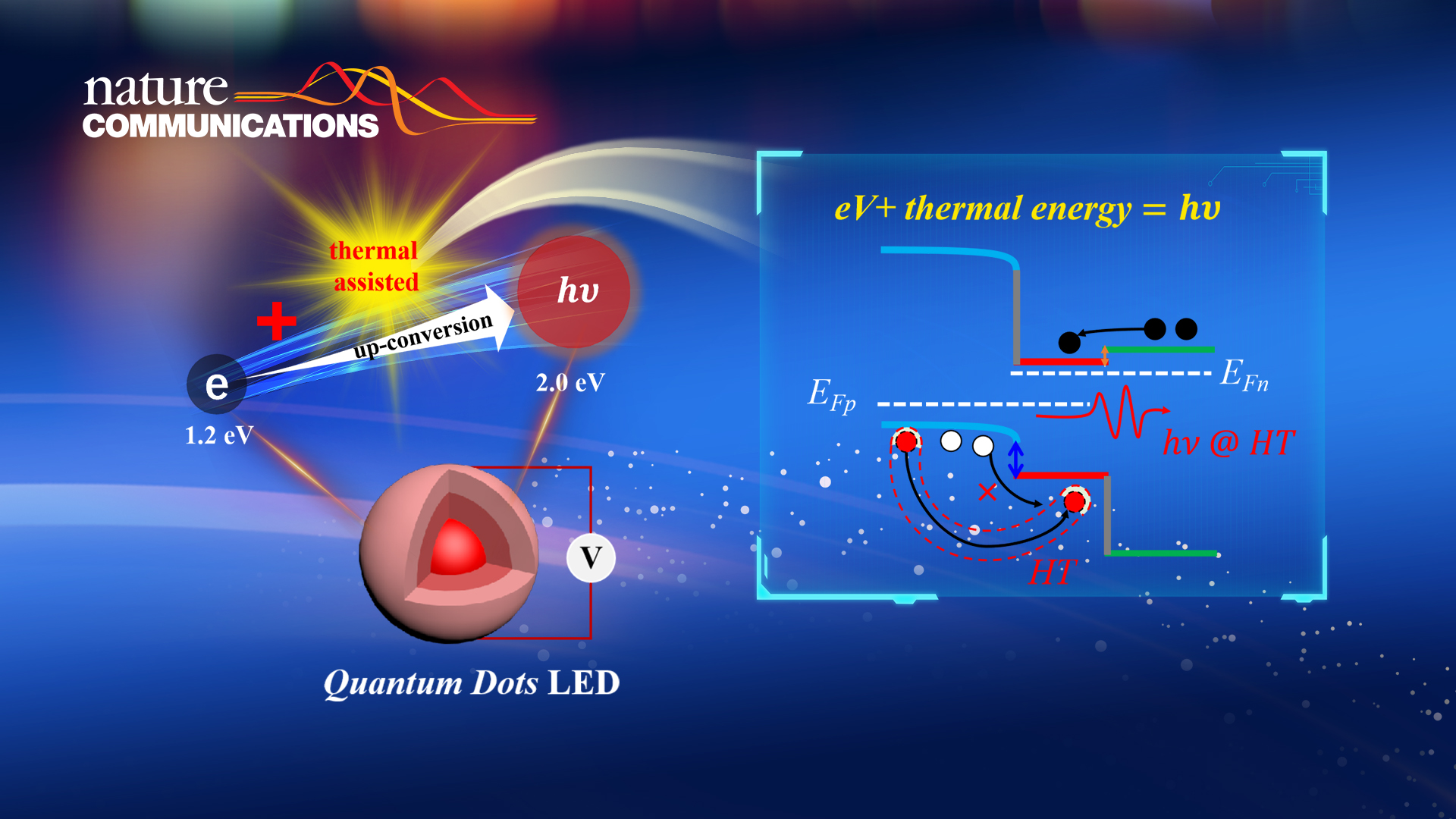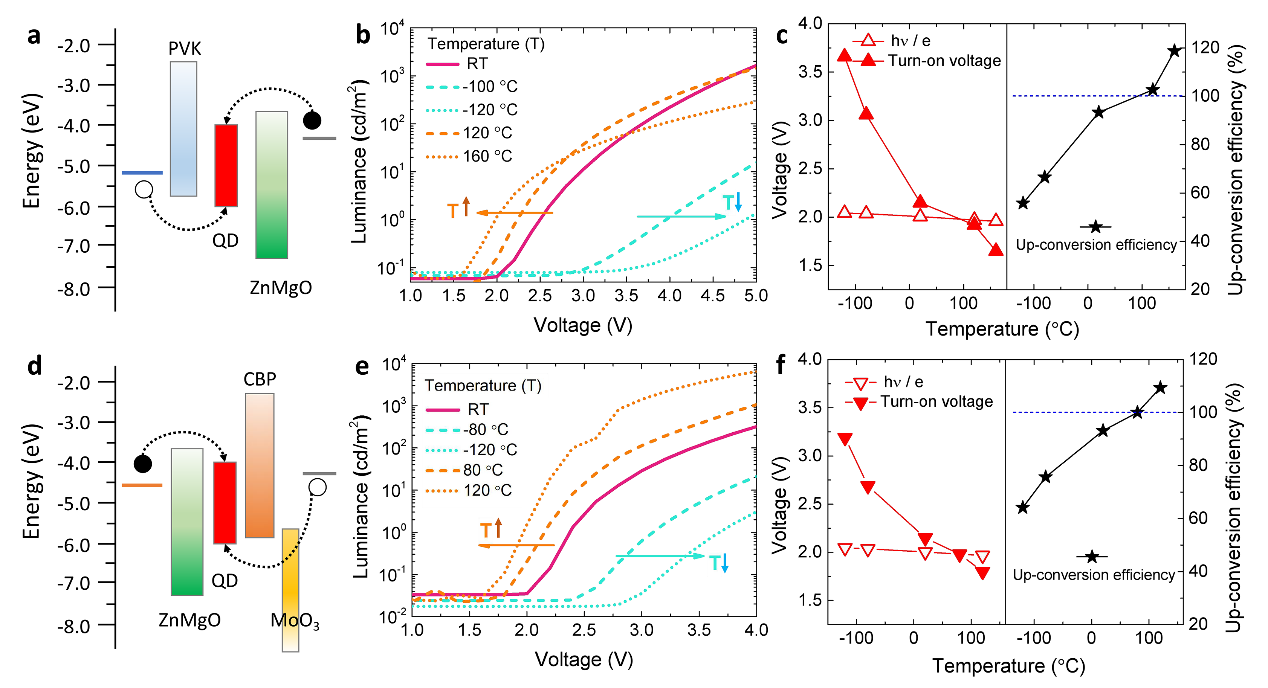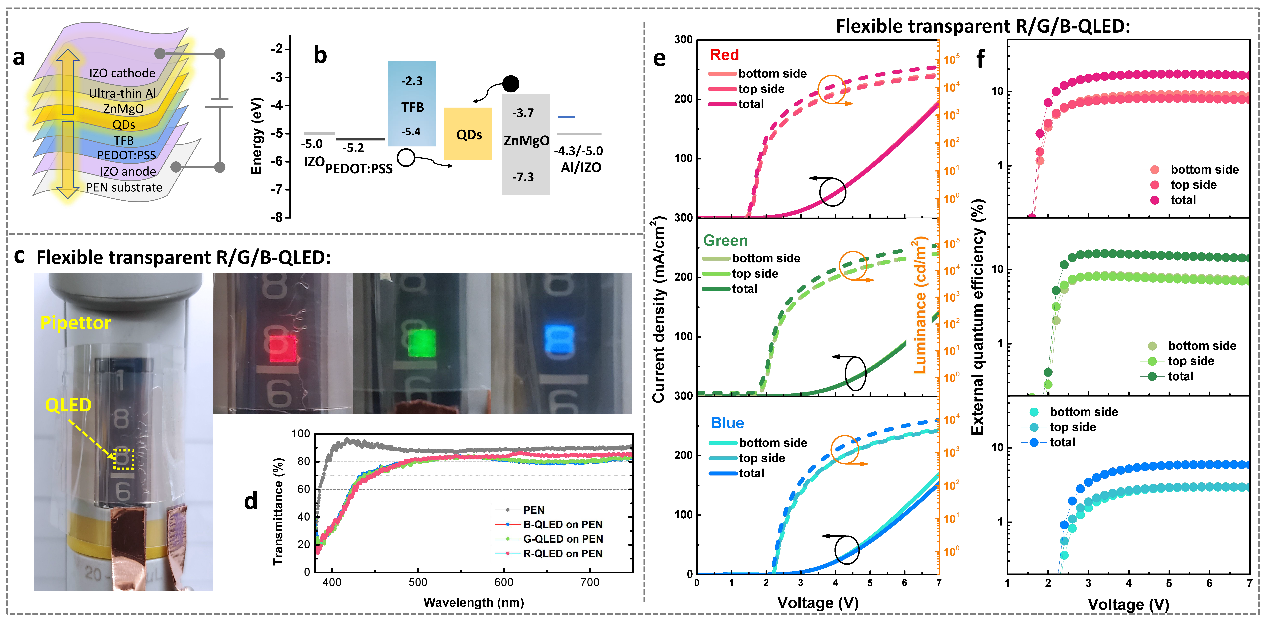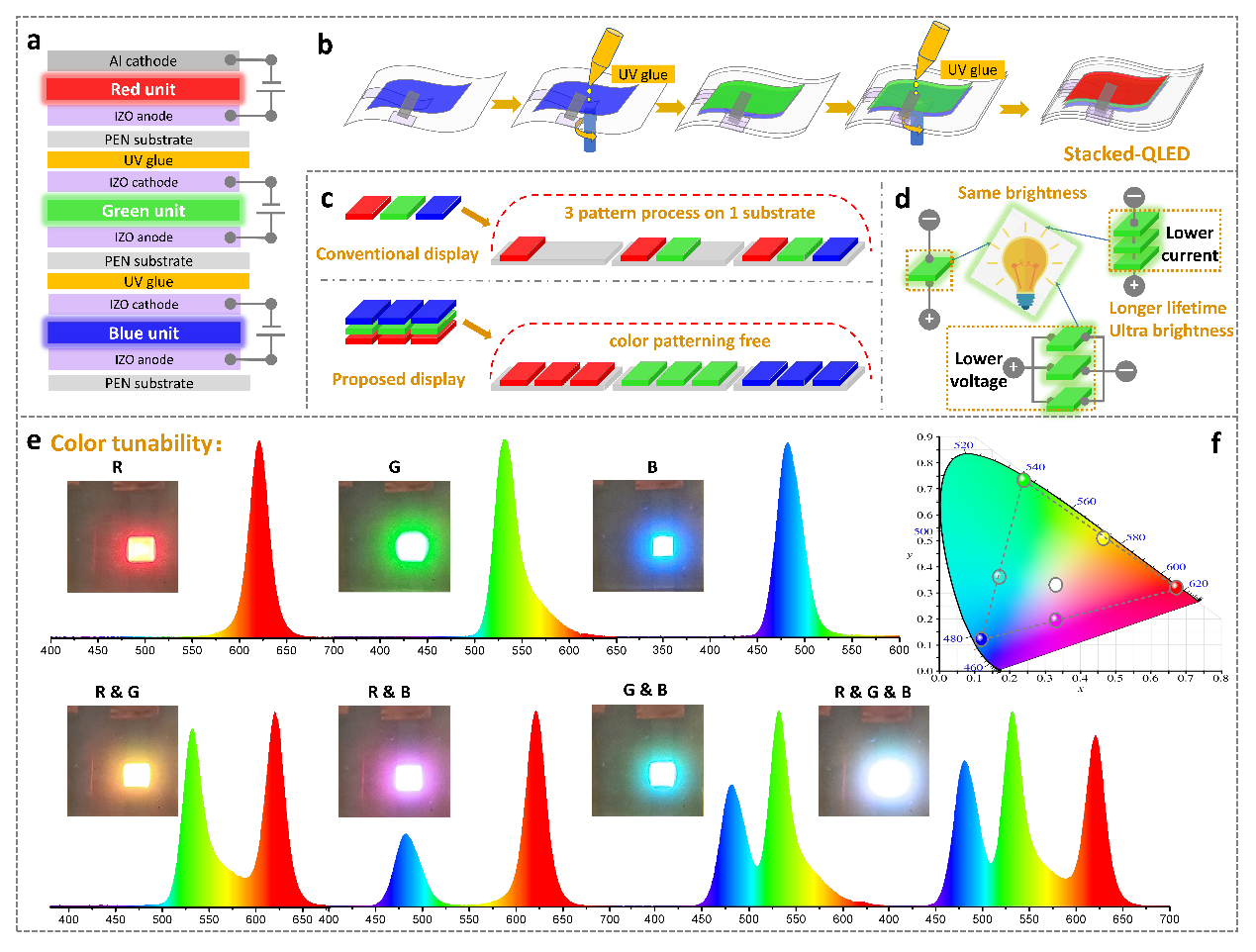Associate Professor Shuming Chen and his research team from the Department of Electronic and Electrical Engineering at the Southern University of Science and Technology (SUSTech) recently disclosed the physical mechanism of up-conversion electroluminescence (EL) in quantum dot light-emitting diodes (QLEDs).
Their research, entitled “Thermal assisted up-conversion electroluminescence in quantum dot light emitting diodes,” was recently published in Nature Communications. Based on the results of temperature-dependent EL and theoretical analysis, they revealed that at sub-bandgap voltage, holes could be successfully injected into quantum dots via a thermal-assisted thermionic-emission mechanism, thereby enabling the sub-bandgap turn-on and up-conversion EL of the devices.

The radiative recombination of excitons leads to the generation of photons with energy of hv (h is Planck constant, v is the photon frequency), which is roughly equal to or slightly smaller than the bandgap energy (Eg) of the QDs. Because the photons are converted from the electrons, the energy of the injected electrons at an applied voltage of V should thus be equal to the energy of photons, i.e., eV = hv ≈ Eg, which implies that the minimum applied voltage or the turn-on voltage VT to induce detectable EL should satisfy VT ≥ hv/e.
However, it has been frequently observed that the VT is substantially smaller than hv/e. For instance, they found that the turn-on voltage to induce a 620 nm red emission in typical QLEDs can be as low as 1.2 V (Movie 1.1), which is far smaller than the bandgap voltage of 2 V. This means that an electron with an energy of 1.2 eV can be up-converted to a 2.0 eV photon.
The observed EL up-conversion is quite interesting, but its mechanism is still debated. Most reports conclude that hole injection into QDs is enabled by Auger-assisted process, field-assisted thermionic-emission, and confinement-enhanced Coulomb interactions. Based on the results of temperature-dependent EL and theoretical analysis, Prof. Chen and his team concluded that thermal-assisted thermionic-emission is the dominant mechanism that accounts for the up-conversion EL in QLED.
Movie 1.1. Thermal assisted up-conversion EL in red QLED
In Figure 1.1, it shows the temperature-dependent EL results of the red, green, and blue QLEDs. An interesting phenomenon that can be observed from Figures 1.1(a)-1.1(c) is that the VT is significantly affected by the temperature. For example, for the red QLED, the VT is decreased to 1.25 V at an elevated temperature of 160 °C, which means that an electron with an energy of 1.25 eV can be up-converted to a 2.0 eV photon. As a result, the up-conversion efficiency can reach a value of 156% (Figure 1.1(e)). At room temperature and a sub-bandgap bias of 1.6 V, the up-conversion EL is switched on and is gradually enhanced when the temperature is further elevated, as demonstrated in Figure 1.1(g). These results indicate that the sub-bandgap turn-on and up-conversion EL are enabled by the thermal-assisted charge injection process.

Figure 1.1. Temperature-dependent EL characteristics
With further theoretical analysis and deduction, the researchers disclosed that hole injection into QDs at sub-bandgap bias is enabled by thermal-assisted thermionic-emission and consequently enables the sub-bandgap turn-on and up-conversion EL.
This work shows that the thermal-assisted hole-injection is a universal mechanism for the up-conversion EL observed in different structured and different colored QLEDs. The up-conversion EL has been commonly observed in regular structures with a TFB hole transport layer and ZnO-based electron transport layer. By replacing the TFB with PVK or CBP, it is difficult to observe the up-conversion EL at RT. However, as shown in Figure 1.2, all devices exhibit the same temperature-dependent EL characteristics when the temperature is varied. Although these devices are built with different HTLs and different architectures, they all show the up-conversion EL at elevated temperature, which can be well explained by the universal thermal-assisted hole-injection mechanism.

Figure 1.2. The up-conversion EL with thermal-assisted in different structured QLEDs
They reported the up-conversion EL in QLED and addressed a fundamental question that had puzzled researchers for years of how the holes are injected into the QDs at sub-bandgap bias. This work uncovers the charge injection process and unlocks the sub-bandgap turn-on mechanism, which paves the road for the development of up-conversion devices with power conversion efficiency over 100%.
In addition, Prof. Chen’s group has made continuous advances in the development of QLED structures. They proposed a flexible tandem QLEDs with individually addressable red/green/blue emission, which could find potential applications in high-resolution displays or color-tunable lighting. Their research, entitled “Flexible and tandem quantum-dot light-emitting diodes with individually addressable red/green/blue emission,” was recently published in npj Flexible Electronics.
Tandem quantum-dot light-emitting diodes (QLEDs) with multiple QLED elements vertically connected by the intermediate electrodes offer the advantages of high brightness and long lifetime. However, it is challenging to address each QLED element individually in conventional tandem structures. To address this challenge in this work, transparent QLEDs built on flexible plasticsubstrates were developed as the building blocks for the tandem QLEDs. By vertically integrating a red, green, and blue transparent QLEDs with an ultraviolet glue, the resultant tandem QLED can emit separately controllable red/green/blue emission with an external quantum efficiency (EQE) of 12.0%/8.5%/4.5%, respectively. Enabled by the transparent and extractable IZO electrodes, the QLED elements can also be connected in series or parallel with an EQE of 24.8% or 8.2%, respectively. This work provides a new implementation strategy for the realization of tandem QLEDs with individually addressable red/green/blue emission for both display and lighting applications.

Figure 2.1. Flexible and transparent red/green/blue-QLED

Figure 2.2. Tandem QLED with individually addressable red/green/blue emission
Movie 2.1. Characteristics of flexible and transparent red/green/blue-QLED
Movie 2.2. Full-color emission characteristics of tandem QLED
Qiang Su, a Ph.D. candidate from SUSTech, is the first author of these papers. Associate Professor Shuming Chen is the corresponding author.
These studies were supported by the National Natural Science Foundation of China (NSFC), Guangdong University Research Program, and the Shenzhen Science and Technology Program.
Paper links:
Nature Communications: https://www.nature.com/articles/s41467-022-28037-w
npj Flexible Electronics: https://www.nature.com/articles/s41528-021-00106-y
To read all stories about SUSTech science, subscribe to the monthly SUSTech Newsletter.
Proofread ByAdrian Cremin, Yingying XIA
Photo By